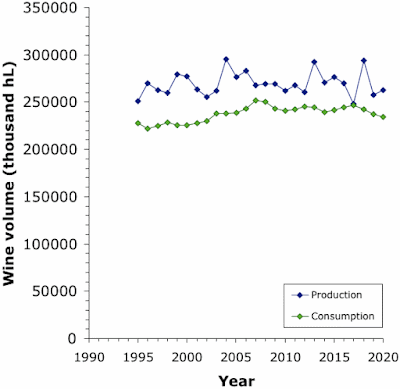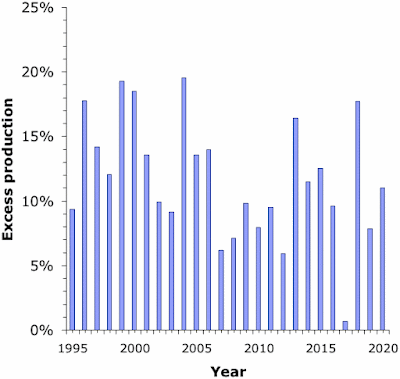Yet, always, year after year, global wine production exceeds consumption, usually by a considerable margin. This has long been known, but rarely discussed; and so it is worth raising the issue again here.
The data I will use to illustrate this point come from The International Organisation of Vine and Wine (OIV), who collate statistics on wine worldwide. The first graph below shows both wine production (in blue) and wine consumption (in green) globally for every year since 1995 (the official 2021 data have not been released yet). These data cover all wines, including sparkling wines and special wines, but exclude juice and musts. Note that a hectoliter (hL) is 100 liters, so that 250,000 in the graph = 25 billion liters.
As you can see, there has been an excess global wine supply every year for at least the past quarter-century (and actually much longer). That is, supply continues to outstrip demand, by an average of 3 billion liters each year. This amount is an average of 11.5% of production, per year, as shown in the second graph (below). That is an awful lot of wine. Only in 2017 could we come even close to claiming that the world needed the amount of wine that was produced.
The really strange thing about these data is that we know perfectly well that Global wine consumption has been declining for a long time. The data that I referred to in that previous post was per capita consumption (ie. per person per year); but you can see in the first graph (above) that, even in terms of total volume there has been a continual decline since 2017, after an increase in consumption until 2007.
Obviously, we expect production to not match consumption for individual countries, which tend to be either producers or consumers (here are some data for 2018). Production in each country will vary from year to year (eg. 2022 harvest to alleviate “rock-bottom” stocks in New Zealand). That is why it is important to concentrate on global wine data. The world has made it repeatedly clear that it does not want or need the amount of wine that the wine industry produces annually.
Now, obviously, the wine industry really does consist of two quite distinct parts. In one part, people discuss terroir, grape varieties, grapevine age, vintage vagaries, and wine cellars; and they are generally ignored by the majority of people on the planet, who find it all too esoteric and (far too often) confusing.* In the other part of the industry, people are trying to make drinks that people will buy and drink.
In the latter case, the customer is always right, because if you tell them they are wrong then they won’t become your customer. So, this part of the wine industry tries to assess what the majority of potential wine drinkers would drink, and then provides it, in whatever way they can, at a price that the customers will pay. This wine is treated as a basic part of life, while the first type seeks its status as an affordable luxury (depending on what you can afford!). The alleged difference between the wine quality of the two is, of course, solely in a perceived assessment, or value judgment. If you personally cannot perceive any difference, or do not care, then there is no practical distinction.
Needless to say, it is the second group that dominates wine industry production, if for no other reason than that they make wine that costs less than US$15, preferably a lot less; and these wines appear on supermarket shelves worldwide, not in specialty stores in only a few big cities. This mass production cannot be done easily if the focus is on places (terroir) and times (vintages). So, the blending of cheap bulk wines is the way to go, along with a few additives like Mega Purple (Mega Purple is the wine ingredient nobody will talk about). Much of this wine is intended for consumption in the year of production.
However, it is also this second part of the industry that is responsible for the over-supply. In spite of what I said above, apparently they first make the wine and only then try to find someone to sell it to (The wine industry is asking the wrong question). This has nothing to do with excess wine that is sold into the bulk wine market — even the bulk market does not want the excess wine that I am discussing here. This situation has long been recognized (Overproduction - the greatest challenges to the wine industry), and is still occasionally discussed even today (Too much wine: the elephant in the room).
For example, 15 years ago the European Union officially faced up to it (How Europe is drowning in wine), decided to do something about it (EU wants to put a cork on excess wine production), and decided to attack it at the source (European Union proposes destroying 1 million acres of vineyards). Prior to this (eg. 2002), the excess wine was simply turned into industrial alcohol:
Since 1981, the EU has been distilling surplus wine into industrial alcohol, which is a costly process. There is an annual budget of c. €220 million, which can be used to distill 11 million hectolitres of wine. Until the 2002 vintage, there had been a crisis distillation each year since the mid-eighties. The last crisis distillation, from the 2001 harvest, removed an extra 7 million hectolitres of wine from the market.The EU response does not seem to have had much effect globally, nor even within the Union itself. For example, in 2020 we had this familiar-sounding report: Europe may have to turn a billion liters of wine into industrial alcohol. At that same time, things were sadly no different elsewhere, either (Vineyard removals still needed to balance California grape supply). If I tried to tell this to someone outside the wine industry, they would collapse laughing.
Evidently, the more things change, the more they stay the same.** Surely we can do better than this?
* For example, when describing a single grape, Albariño: “There are also huge differences between sub-regional styles, influenced by soil type, altitude, rainfall, sunshine hours, vineyard orientation and proximity to the rivers, estuaries and the Atlantic Ocean that are such important features of Rías Baixas’ unique terroir” (The rain In Spain).
** Way back in 1849, French writer Jean-Baptiste Alphonse Karr wrote: “plus ça change, plus c’est la même chose”. The truth of this expression, whether in French or English, has not changed much since then, either!




No comments:
Post a Comment